Abstract
Bulbophyllum lipingtaoi, a new orchid species from Yunnan, China, is described and illustrated. Detailed comparative morphological analyses indicate that this new orchid is distinct from other species of Bulbophyllum in having a single-flowered inflorescence with a scape arising from the node of the rhizome, entire margins of sepals and petals, and lateral sepals twisted near base. Furthermore, molecular phylogenetic analyses based on nuclear ribosomal ITS and plastid DNA (matK and atpI-atpH) support the placement of B. lipingtaoi as a member of section Brachyantha. Section Brachyantha is usually characterized by a 2- to many-flowered inflorescence, hence the solitary flower of B. lipingtaoi should be treated as an apomorphy.

